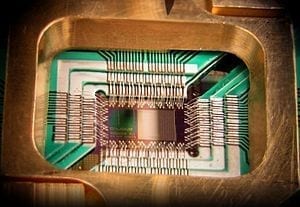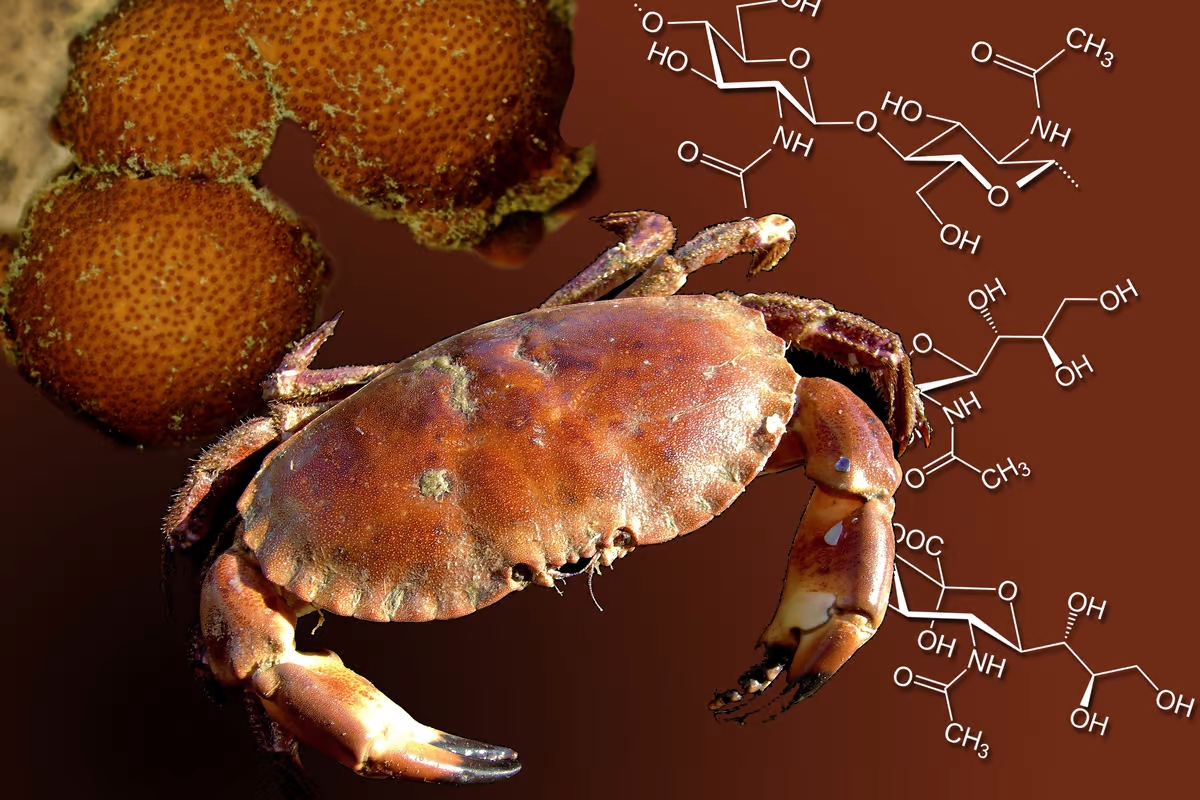
New research finds that prototype quantum optimization chip operates as hoped
A team of scientists at USC has verified that quantum effects are indeed at play in the first commercial quantum optimization processor.
The team demonstrated that the D-Wave processor housed at the USC-Lockheed Martin Quantum Computing Center behaves in a manner that indicates that quantum mechanics plays a functional role in the way it works. The demonstration involved a small subset of the chip’s 128 qubits.
This means that the device appears to be operating as a quantum processor – something that scientists had hoped for but have needed extensive testing to verify.
The quantum processor was purchased from Canadian manufacturer D-Wave nearly two years ago by Lockheed Martin and housed at the USC Viterbi Information Sciences Institute (ISI). As the first of its kind, the task for scientists putting it through its paces was to determine whether the quantum computer was operating as hoped.
“Using a specific test problem involving eight qubits we have verified that the D-Wave processor performs optimization calculations (that is, finds lowest energy solutions) using a procedure that is consistent with quantum annealing and is inconsistent with the predictions of classical annealing,” said Daniel Lidar, scientific director of the Quantum Computing Center and one of the researchers on the team, who holds joint appointments with the USC Viterbi School of Engineering and the USC Dornsife College of Letters, Arts and Sciences.
Quantum annealing is a method of solving optimization problems using quantum mechanics – at a large enough scale, potentially much faster than a traditional processor can.
Research institutions throughout the world build and use quantum processors, but most only have a few quantum bits, or “qubits.”
Qubits have the capability of encoding the two digits of one and zero at the same time – as opposed to traditional bits, which can encode distinctly either a one or a zero. This property, called “superposition,” along with the ability of quantum states to “tunnel” through energy barriers, are hoped to play a role in helping future generations of the D-Wave processor to ultimately perform optimization calculations much faster than traditional processors.
With 108 functional qubits, the D-Wave processor at USC inspired hopes for a significant advance in the field of quantum computing when it was installed in October 2011 – provided it worked as a quantum information processor. Quantum processors can fall victim to a phenomenon called “decoherence,” which stifles their ability to behave in a quantum fashion.
The USC team’s research shows that the chip, in fact, performed largely as hoped, demonstrating the potential for quantum optimization on a larger-than-ever scale.
The Latest Bing News on:
Large-scale quantum chip
- Pure silicon extraction promises quantum computing advanceson May 7, 2024 at 7:14 am
Researchers unveil a refined silicon production technique, crucial for high-performance qubit devices and advancing quantum computing.
- Million qubits chip a possibility, could enable practical quantum computerson May 7, 2024 at 5:28 am
The breakthrough opens the door to integrating millions of qubits on a single chip using mature manufacturing processes. For practical quantum computers to become a reality, breakthroughs like this ...
- Quantum computing breakthroughs draw investment back to sectoron May 4, 2024 at 4:00 am
A series of research breakthroughs, starting with Google last year, has brought major advances in error correction years earlier than most expected. Research results from Harvard University and Boston ...
- How will gate-based quantum computers scale-up in future?on May 1, 2024 at 1:46 pm
Building a large-scale, fault-tolerant, gate-based machine to solve ... with many players struggling to recruit the physicists, quantum engineers, chip designers, and computer scientists, that they ...
- Quantum Computers Newson April 30, 2024 at 5:00 pm
Lead-Vacancy Centers in Diamond as Building Blocks for Large-Scale Quantum Networks ... Accurately Centering Quantum Dots Within Photonic Chips Mar. 26, 2024 — Researchers have now developed ...
- The $1 Billion Bet on Quantum Computers That Process Lighton April 30, 2024 at 12:30 pm
PsiQuantum wants to make quantum computers in the same way as microchips are made today. So how is it doing?
- Quantum Computing Newson April 28, 2024 at 5:00 pm
The breakthrough opens up the possibility of integrating millions of these qubits on a single chip using mature ... as Building Blocks for Large-Scale Quantum Networks Apr. 24, 2024 ...
- China launches 504-qubit quantum chip, open to global userson April 26, 2024 at 3:47 am
Gong Ming, a researcher at the center, said that the main purpose of the chip is to promote the development of large-scale quantum computing measurement and control systems, rather than to aim for ...
- Demonstration of heralded three-photon entanglement on a photonic chipon April 25, 2024 at 3:40 am
Employing this method, the researchers were able to this state from a single-photon source in a photonic chip ... the development of large-scale optical quantum computers that rely on 3-GHZ ...
- Progress on chip-based spontaneous four-wave mixing quantum light sourceson April 1, 2024 at 9:36 am
Importantly, the exploration of on-chip integration has accumulated substantial progresses in recent years, towards the realization of low-cost, large-scale quantum photonic circuits. With rapid ...
The Latest Google Headlines on:
Large-scale quantum chip
[google_news title=”” keyword=”Large-scale quantum chip” num_posts=”10″ blurb_length=”0″ show_thumb=”left”]
The Latest Bing News on:
Quantum optimization chip
- 'World's purest silicon' could lead to 1st million-qubit quantum computing chipson May 11, 2024 at 5:00 am
Scientists engineer the 'purest ever silicon' to build reliable qubits that can be manufactured to the size of a pinhead on a chip and power million-qubit quantum computers in the future.
- Intel's quantum leap in wafer-wide cryo-testing sets cool new standardon May 8, 2024 at 2:47 am
"High-volume testing with the cryoprober will continue to enable process optimization to reduce variation and disorder, as well as more advanced performance screening to identify the leading-edge test ...
- Super-Pure Silicon Chip Opens Path to Quantum Computerson May 7, 2024 at 10:00 pm
Researchers at the Universities of Melbourne and Manchester have invented a breakthrough technique for manufacturing highly purified silicon that brings powerful quantum computers a big step closer. T ...
- Ultra-Pure Silicon Chip Sparks a Quantum Computing Revolutionon May 7, 2024 at 8:07 pm
Researchers at the Universities of Melbourne and Manchester have invented a breakthrough technique for manufacturing highly purified silicon that brings powerful quantum computers a big step closer. T ...
- Million qubits chip a possibility, could enable practical quantum computerson May 7, 2024 at 5:31 am
Researchers from Basel University and NCCR have made a major breakthrough that could lead to creation of million qubit chips.
- New super-pure silicon chip opens path to powerful quantum computerson May 6, 2024 at 4:59 pm
Lead author Ravi Acharya, a joint University of Manchester/University of Melbourne Cookson Scholar, said the great advantage of silicon chip quantum computing was it used the same essential ...
- 'World's purest silicon' could lead to 1st million-qubit quantum computing chipson May 6, 2024 at 4:59 pm
Scientists engineer the 'purest ever silicon' to build reliable qubits that can be manufactured to the size of a pinhead on a chip and power million-qubit quantum computers in the future.
- New super-pure silicon chip opens path to powerful quantum computerson May 6, 2024 at 4:59 pm
Lead author Ravi Acharya, a joint University of Manchester/University of Melbourne Cookson Scholar, said the great advantage of silicon chip quantum computing was it used the same essential techniques ...
- Quantum Computers Newson April 30, 2024 at 5:00 pm
Accurately Centering Quantum Dots Within Photonic Chips Mar. 26 ... Algorithm for High-Quality Solutions to Combinatorial Optimization Problems Mar. 25, 2024 — Conventional quantum algorithms ...
- Buy Rating Affirmed for Quantum Computing Inc. on Strong Growth Prospects and Strategic Acquisitionson April 14, 2024 at 8:16 pm
Additionally, Quantum’s flagship software, Qatalyst, positions it at the forefront of optimization computations ... information science and domestic chip manufacturing. While adjusting the ...
The Latest Google Headlines on:
Quantum optimization chip
[google_news title=”” keyword=”quantum optimization chip” num_posts=”10″ blurb_length=”0″ show_thumb=”left”]











